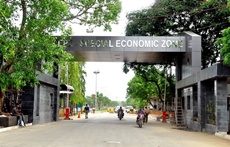US drags India to WTO over export subsidy schemes like SEZs
16 Mar 2018
The Trump administration has dragged India to the World Trade Organisation (WTO) for providing what it termed as export subsidies through half-a-dozen schemes, including Special Economic Zones (SEZs) and the Merchandise Exports from India Scheme.
 India will engage with the US to explain the legitimacy of its export subsidy schemes following America's decision to approach the WTO on the issue, commerce secretary Rita Teotia said on Thursday. Teotia told journalists that India has not violated any WTO norms and it would soon respond to the USA's application.
India will engage with the US to explain the legitimacy of its export subsidy schemes following America's decision to approach the WTO on the issue, commerce secretary Rita Teotia said on Thursday. Teotia told journalists that India has not violated any WTO norms and it would soon respond to the USA's application.
In its request to hold consultations with India, the first step before legal action, the US has argued that the incentives violate WTO agreements as India is no longer below the economic benchmark of $1,000 per capita gross national income (GNI).
''These export subsidy programmes harm American workers by creating an uneven playing field on which they must compete. USTR will continue to hold our trading partners accountable by vigorously enforcing US rights under our trade agreements and by promoting fair and reciprocal trade through all available tools, including the WTO,'' US Trade Representative Robert Lighthizer said. The US has estimated the quantum of incentives offered by India at $7 billion.
A WTO member country gets 60 days to respond. "The US has asked for a consultation process, we will engage fully in the process and we would make sure that we make our position known to the US. We expect that they would also engage with a positive spirit with an effort to resolve a dispute with a friendly country," Teaotia said.
India argues that like other countries in the past, India should be allowed a transition period of eight years.
When the WTO was set up, developing countries that had a GNI of over $1,000 per capita were allowed eight years to wind up their export promotion schemes.
''Our presumption is that India also has a similar period of eight years to graduate out of the subsidy regime and this is what we will be placing before the US. We are hopeful that they will recognise this time frame and during this time frame we will commit ourselves and meet our obligations,'' Teaotia said, adding that India was not offering subsidies but many of the ''incentives'' were meant to neutralise the impact of taxes.
Besides, some other countries which achieved the benchmark later, such as Egypt and Sri Lanka, have been allowed the transition period, Indian officials said, and accused the Trump administration of targeting India as part of a strategy focused on pleasing its domestic constituency.
US authorities have launched a multi-pronged strategy to address domestic concerns over job losses due to off-shoring of services and imports from countries such as China and India. In recent months, visa rules for technology professionals have been tightened and import duties on several products have been increased, steel and aluminium being the most recent instances.
On the latest move, Indian officials pointed to the anomaly in the WTO treaties and said a country which had $950 per capita GNI may not be allowed a transition period, while a country above the threshold at the time the agreement came into force got eight years to wind up incentives.
Teaotia said that India had flagged the issue back in 2011. While the WTO had pointed out that India breached the benchmark in 2015, the eight-year transition period should be calculated from 2017, when the multilateral trade body pointed it out.
The US accused India of not just continuing with the incentives, which were allowed till the limit was exceeded in 2015, but said the government expanded the scope of the programme.
Experts seemed not particularly worried by the US action, even though India's exports of goods to the US touched a multi-year high last calendar year. The US currently contributes around 15 per cent to India's overall exports and is a key trading partner.
According to economists, reaching a conclusion on complaints relating to anti-dumping is a long-drawn process. Also, since WTO has asked India and the US to bilaterally iron out the differences, it is too early to hit the panic button.







.webp)














